Photos of Philanthrophy
20.12.2011

Tens of thousands of Armenian children fell victim to the Genocide premeditated and perpetrated by the Turkish government. Those who could survive became orphans devoid of parental care; some of them were deprived of the Armenian environment and lost their identity. The Turkish government established special orphanages with the intent to Turkify and Islamize them.
After the Genocide numerous Armenian and international organizations as well as individual relief workers tried to rescue the Armenian survivors. A humanitarian mission unprecedented in the world history aimed at rescuing and ransoming thousands of Armenian women and children who had forcibly been Turkified and Islamized. The American “Near East Relief” organization founded in 1915, was one of the pioneers in this mission.
The seventeen photos, presented below, were revealed on the initiative of the Armenian Genocide Museum-Institute in a family archives living in Yerevan. These photos present the orphan-care activity of the Near East Relief in Alexandrapol (now Gyumri, Armenia), Palestine and Lebanon.
Indeed, these photos have their unique place in the chronicle of the world humanitarian history.
The National Assembly of France Adopts the Bill Criminalizing the Denial of the Armenian Genocide
22.12.2011

The National Assembly of France has adopted the bill criminalizing the denial of the Armenian Genocide by overwhelming majority of voices.
The new bill envisages one year of imprisonment and 45 thousand euros of fine for anyone who will deny the Armenian Genocide. The bill must be presented to the upper chamber of the French Parliament—the Senate—for approval.
The author of the bill is Valérie Boyer. The French MPs noted that it has been done for the victims of the Armenian Genocide. The country of human rights did not tolerate the denial of the Armenian Genocide. The members of the French Parliament stated that those denying the Genocide take part in collective annihilation.
France recognized and condemned the Armenian Genocide as early as 2001.
President of Lebanon Michel Sleiman Paid Tribute to the Memory of the Armenian Genocide Victims
09.12.2011
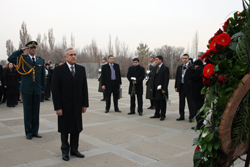
President of Lebanon Michel Sleiman, who is in Armenia on an official visit, accompanied by his spouse Wafaa Sleiman visited Tsitsernakaberd Memorial Complex and put a wreath at the memorial of the Armenian Genocide victims.
The members of the Lebanese delegation put flowers at the Eternal Fire and honored the memory of the innocent victims with a minute of silence.
President of Lebanon and his accompanying delegation visited Armenian Genocide Museum and took a tour of the museum after which President Michel Sleiman left the following note in the Commemoration Book. “The one, who stands in front of this monument, sees the glorious history of struggle and sacrifice. I wish prosperity to the friendly Armenian people”.
The director of the Armenian Genocide Museum-Institute Hayk Demoyan handed President of the Republic of Lebanon Michel Sleiman a Golden medal which is given to the high-ranking officials who visit Armenian Genocide Museum.
The members of the Lebanese delegation also had a tour of the Memory Alley, where President of Lebanon Michel Sleiman planted a fir.
It should be noted that in 2000 the Lebanese Parliament recognized and condemned the genocide carried out in 1915 against the Armenian people.
AGMI Website Became Winner in the Pan-Armenian Competition
06.12.2011
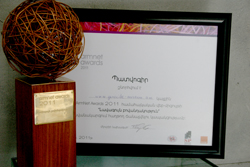
The website of the Armenian Genocide Museum-Institute became a winner in the pan-Armenian competition “ArmNet Awards” project with award conditions, competed for the sites, which have been established for 2009-2011, or during this period of time or have undergone significant changes (design, content, technology used).
The sites of the competition was for Armenian (Armenia or Diaspora) market, or present the culture, the history, the problems of Armenia, Armenians, Armenian Diaspora, or are completely made by a company registered in Armenia. Over 650 websites were submitted to the jury of the competition.
AGMI website became the prize winner from eight nominations in "The Best Content" category, which was planned for the site, which is distinguished by original, interesting and literate content. Note that this is the second similar success of AGMI website. In 2008 AGMI was the main winner in the pan-Armenian competition of the electronic content, as well as winner in the e-Science category. See http://genocide-museum.am/arm/17.01.2009.php
100 Concerts Dedicated to the 100th Anniversary of the Armenian Genocide
06.12.2011
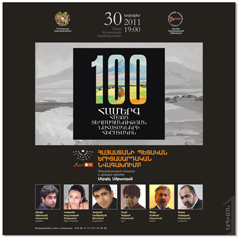
The Ministry of Culture, the Pyunik Human Resource Development Center and the Armenian Genocide Museum-Institute present series of 100 concerts in memory of the Armenian Genocide victims within the framework of the events dedicated to the 100th anniversary of the Armenian Genocide.
On November 30 the first concert of these series took place at Aram Khachatryan Concert Hall. The State Youth Orchestra of Armenia and the UNICEF Children Orchestra under the guidance of the Artistic Director and Principal Conductor of the Orchestra Sergey Smbatyan took part in that concert.
Not only Armenian but also foreign famous artists will participate in these concerts dedicated to the 100th anniversary of the Armenian Genocide. The concerts will take place both in Armenia, in Artsakh and in different cities of the world. They will be free and available to everybody.
The next concert will take place in Germany.
“Let me see Ani…” exhibition was opened in History Museum of Yerevan.
30.11.2011
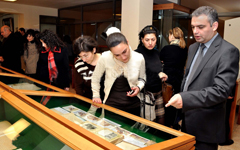
On November 29 exhibition dedicated to the 1050 anniversary of the proclamation of Ani as the capital of Bagratid Armenia opened in the History Museum of Yerevan.
Documents, photos, canvases, books, postcards and maps concerning the history of the historical capital Ani were presented at the exhibition. The exhibition items were brought from the Armenian National Gallery, National Archive, Armenian Genocide Museum-Institute and Yerevan History Museum.
The director of Yerevan History Museum Armine Sargsyan, the director of the Armenian Genocide Museum-Institute Hayk Demoyan and the director of the Institute of Archeology and Ethnography Pavel Avetisyan made their opening speeches.
CLARA BARTON - 190
ARMENIAN MISSION OF THE “ANGEL OF THE BATTLEFIELD”
18.11.2011

115 years ago in the month of February Clara Barton, founder and chairperson of the U.S. Red Cross arrived in Constantinople, capital city of Ottoman Empire to offer some relief to Armenian population, victims of the massacres of 1894-96.
Clarissa Harlowe Barton was born in North Oxford, Massachusetts on December 25, 1821. In 1852 in Bordentown she established the first institution to provide free education in the state of New Jersey. In 1854 she moved to Washington D.C. and was employed by the U.S. Patent Office. This was the first time a woman had received a substantial clerkship in the federal government. During the Civil War (1861-65) Clara fully dedicated herself to providing relief and care to wounded soldiers. As a result of her untiring work, she became known as the "Angel of the Battlefield."
Barton also was highly dedicated to fighting for and furthering the rights of women.
At the end of 1895 the American Red Cross and C. Barton were requested by the National Armenian Relief Committee and Board of Missionaries to undertake the distribution of relief funds among the sufferers.
On December 14, 1895 C. Barton announced that the American Red Cross would send a relief expedition to Armenia as soon as sufficient funds were available to aid the estimated 350 thousand destitute and starving people.
On February 16 C. Barton got to Constantinople.
Given the good reputation of the American Red Cross and its chairperson Sublime Porte authorizes this organization to offer relief and agricultural rehabilitation programs to the regions and population suffered as result of Armenian massacres.
The Co-founder of "Apple Computers" Corporation Steve Wozniak Visited Tsitsernakaberd Memorial Complex
11.11.2011

The co-founder of "Apple Computers" corporation Steve Wozniak visited Tsitsernakaberd Memorial Complex, put flowers at the Eternal Fire and honored the memory of the innocent victims with a minute of silence.
The famous co-founder of "Apple Computers" corporation Steve Wozniak visited Armenian Genocide Museum, took a tour of the museum and left a note in the Commemoration Book.
Steve Wozniak also had a tour of the Memory Alley, where the co-founder planted a fir.
A monument dedicated to Fridtjof Nansen was erected in the capital
10.11.2011

The monument of the friend of the Armenian nation, polar explorer, scientist, statesman, humanist, Nobel Laureate Fridtjof Nansen was erected on the cross-roads of Abovyan and Moskovyan streets in Yerevan as a part of celebrations of his 150th anniversary.
The president of the Republic of Armenia Serzh Sargsyan, high-ranking officials, as well as the Minister of Foreign Affairs of the kingdom of Norway Jonas Gahr Store and granddaughter of Fridtjof Nansen Marit Greve were present at the opening ceremony. The director of the Armenian Genocide Museum Institute Hayk Demoyan made an opening speech at the ceremony. After the unveiling of the monument President Serzh Sargsyan handed Mrs. Marit Grev the passport of the Republic of Armenia which provides the holder with a special statue and expressed his gratitude on behalf of the Armenian nation since Fridtjof Nansen gave thousands of Armenians the opportunity to find their place in the world by providing them such passports.
Foreign Affairs Minister of the Kingdom of Norway Paid Tribute to the Memory of the Armenian Genocide Victims
09.11.2011

Minister of Foreign Affairs of the Kingdom of Norway Jonas Gahr Støre and his accompanying delegation visited Tsitsernakaberd Memorial Complex and put a wreath at the memorial of the Armenian Genocide Victims.
The members of the Norwegian delegation laid flowers at the Eternal Fire and honored the memory of the innocent victims with a minute of silence.
Foreign Affairs Minister of the Kingdom of Norway Jonas Gahr Støre visited Armenian Genocide Museum, took a tour of the museum and left a note in the Commemoration Book.
The members of the delegation also had a tour of the Memory Alley, where Minister Jonas Gahr Støre planted a fir.
The director of the Armenian Genocide Museum and Institute Hayk Demoyan gave golden medals “Fridtjof Nansen 150”, which have been issued lately, to Foreign Affairs Minister of the Kingdom of Norway Jonas Gahr Støre, Royal Family of Norway and granddaughter of Fridtjof Nansen Marit Greve.
AGMI won Gold medal in the republican philatelistic exhibition dedicated to the 20th anniversary of the Republic of Armenia
09.11.2011

The union of the philatelists of Armenia opened a republican philatelistic exhibition in Yerevan city’s History Museum dedicated to the 20th anniversary of the Republic of Armenia and Yerevan day. For the first time AGMI participated in such kind of exhibition presenting philatelistic items from the museum collection under the name “Genocide and humanitarianism”.
The exhibition included postcards, covers, rare stamps, non-postal charity stamps etc. The memorial postcard issued by the AGMI also were the part of the exhibition. The exhibition was prepared by the efforts of the AGMI researchers Gohar Khanumyan and Tatevik Ghalthakhchyan.
Based on the decision of the jury AGMI exhibition was awarded with Gold medal.
Mayor of Montreal Gérald Tremblay Visited Tsitsernakaberd Memorial Complex
27.10.2011
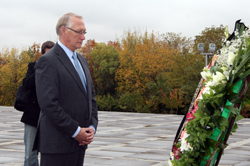
Mayor of Montreal Gérald Tremblay, who has arrived in Armenia to take part in the General Conference of the International Association of Francophone Mayors, visited Tsitsernakaberd Memorial Complex and laid a wreath at the Memorial of the Armenian Genocide victims. The members of the Canadian delegation put flowers at the eternal fire and honored the memory of the innocent victims with a minute of silence.
Mayor of Montreal Gérald Tremblay also visited Armenian Genocide Museum, took a guided tour of the museum and left a note in the Commemoration Book.
Mayor of Montreal and the members of his delegation had a tour of the Memory Alley where Mayor Gérald Tremblay watered the fir which has been planted within one of the previous visits.
Mayor of Paris: “I call to forbid the Genocide Denial”
25.10.2011
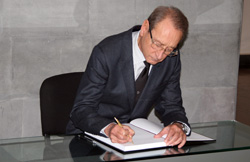
Mayor of Paris Bertrand Delanoe, who has arrived in Armenia to take part in the General Conference of the International Association of Francophone Mayors, visited Tsitsernakaberd Memorial Complex and laid a wreath at the Memorial of the Armenian Genocide victims. The members of the French delegation put flowers at the eternal fire and honored the memory of the innocent victims with a minute of silence.
Mayor of Paris Bertrand Delanoe, accompanied by the director of AGMI Hayk Demoyan, visited Armenian Genocide Museum, took a guided tour of the museum and left the following note in the Commemoration Book: “I pay tribute to the memory of the Armenian Genocide victims with deep regard and call to forbid Genocide denial”.
The members of the French delegation had a tour of the Memory Alley where Mayor Bertrand Delanoe planted a fir.
CIS Internal Affairs Ministers Paid Tribute to the Memory of the Armenian Genocide Victims
15.10.2011
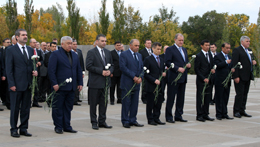
CIS Internal Affairs Ministers, arrived in Armenia on October 14, 2011, accompanied by chief of the Republic of Armenia police Alik Sargsyan visited Tsitsernakaberd Memorial Complex and laid a wreath at the Memorial of the Armenian Genocide victims. The high-ranking officials of the CIS countries put flowers at the eternal fire and honored the memory of the innocent victims with a minute of silence.
The Ministers of Internal Affairs accompanied by the director of AGMI Hayk Demoyan visited Armenian Genocide museum where they took a guided tour of the museum and left a note in the Commemoration Book.
Afterwards the CIS delegation members have a tour of the Memory Alley where Russian Minister of Internal Affairs Rashid Nurgalin watered the fir which has been planted within one of the previous visits.
Nobel Laureate Zhores Alferov visited Tsitsernakaberd Memorial Complex
13.10.2011

Zhores Alferov, Nobel Laureate in Physics, Vice-President of the Russian Academy of Sciences, who has lately been elected as an Honorary Member of National Academy of Sciences of Republic of Armenia visited Tsitsernakabed Memorial Complex and put flowers at the memorial of the Armenian Genocide victims and honored the memory of the innocent victims with a minute of silence.
Russian Nobel Laureate Zhores Alferov accompanied by his spouse visited Armenian Genocide Museum and took a tour of the museum after which left a note in the Commemoration Book.
Zhores Alferov is a Laureate of Nobel Prize as he is an inventor of fast opto- and microelectronic components based on layered semiconductor structures, known as heterostructures. He is an Honorary Member of more than 50 scintific-educational centers of the world. Alferov has 500 scholarly articles, 3 books and 50 inventions.
Fridtjof Nansen – 150
11.10.2011
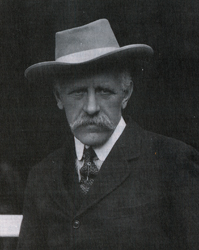
Norwegian polar explorer, scientist, statesman, humanitarian and Nobel Laureate Fridtjof Nansen, who is also famous for his devotion to the Armenians, was born on October 10, 1861.
After World War I, Nansen actively participated in the works of the League of Nations. From 1920 to 1922 he was the League’s High Commissioner for the Repatriation of the prisoners of war. In 1921 Nansen was appointed the High Commissioner of Refugees and organized the exchange of war prisoners and the return of refugees.
Nansen proposed the League of Nations to validate the “Nansen Passport”, which gave the stateless people the right to enter different countries. Thanks to these passports 320 000 Armenians got the right to move freely to their preferred country.
In 1924, at the League’s request, Fridtjof Nansen began studying the question of the repatriation of the Armenian refugees. In June 1925 the committee headed by Nansen visited Soviet Armenia. Due to Nansen’s best endeavors, 7000 Armenian refugees were repatriated.
Fridtjof Nansen died on May 30, 1930, in Norway.
Armenian Genocide-Museum and Institute issued a nominal postcard and also a medal “Fridtjof Nansen 150” on the occasion of the 150th anniversary of Fridtjof Nansen.
President of France Nicolas Sarkozy Paid Tribute to the Memory of the Armenian Genocide Victims
06.10.2011

President of France Nicolas Sarkozy, within the framework of his two-day state visit to Armenia, accompanied by RA President Serz Sargsyan visited Tsitsernakaberd Memorial Complex. President of Armenia and President of France put wreaths at the memorial of the Armenian Genocide Victims.
President of France Nicolas Sarkozy and accompanying delegation laid flowers at the Eternal Fire and honored the memory of the innocent victims with a minute of silence.
The Armenian and the French delegations headed by two presidents visited Armenian Genocide Museum and took a tour of the museum. The director of the Armenian Genocide Museum and Institute Hayk Demoyan introduced the guests to the museum exhibition which on the occasion of the visit of high-ranking officials has been completed with new materials. President of France Nicolas Sarkozy left a note in the Commemoration Book, which reads: “France doesn’t forget”.
Afterwards the members of delegation arrived from France had a tour of the Memory Alley, where President Sarkozy planted a fir.
In 2001, France became the first country which recognized the Armenian Genocide by special law.
Speaker of Lebanese Parliament visited Tsisternakaberd
03.10.2011
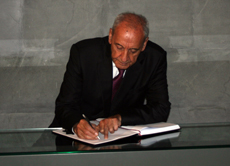
On October 3, Speaker of the Lebanese parliament Nabih Berri, who is in Armenia on an official visit, visited Tsitsernakaberd Memorial Complex and put a wreath at the memorial of the Armenian Genocide victims.
The members of the Lebanese delegation put flowers at the eternal fire and honored the memory of the innocent victims with a minute of silence.
Speaker of the Lebanese parliament Nabih Berri also visited Armenian Genocide Museum, took a guide tour of the museum and left the following note in the Commemoration Book. “I feel deep sorrow for the tragedy of the Armenian people”.
Nabih Berri planted a fire at the Memorial Alley of Tsitsernakaberd Complex.
International conference on the Armenian Genocide held in Copenhagen
29.09.2011
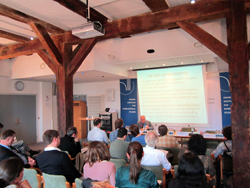
The international conference “Aid and Genocide: Scandinavian Relief Work Among the Christian Minorities In the Ottoman Empire” was held in September 26-27, 2011 in Copenhagen organized by Danish Institute for International Studies, DIIS. The conference focused on the relief work that was conducted among Armenians and other Christian minorities of Ottoman Turkey before, during and after World War I by Scandinavian missionaries. Furthermore, it is intended to provide a contextual understanding of the genocidal policies in the Ottoman Empire. A special panel of the conference covered the Armenian Genocide.
The papers presented at the conference covered the recent research carried out in Denmark, Norway, Sweden and Armenia on the relief work in the Ottoman Empire enabling deeper understanding of the relief work itself, its background and function, as well as the reactions of the Scandinavian countries on the genocide and of the state of foreign policy in general.
Director of the AGMI Hayk Demoyan presented a paper titled “Contextualizing the History of the Armenian Genocide. Scandinavian Responses and Memories”.
Jakob Künzler 140
24.09.2011

Jakob Künzler was born on March 8, 1871 in Hundwil, Switzerland. Working as an orderly in one of the hospitals in Basel, Künzler met Doctor Hermann Christ. Soon the Deutche Orient-Mission (German Mission of the East) run by Johannes Lepsius sent Dr. Christ to Urfa. At the latter’s invitation Künzler left for Urfa in 1899 and became his assistant. Due to his nature and diligence he managed to establish good relations with multinational population of Urfa.
The years of the World War I were particularly difficult for J. Künzler as sometimes he was the only one who could provide medical assistance in Urfa and in surroundings. From 1914 to 1918 Jakob Künzler and his wife Elizabeth could save many Armenians from upcoming death.
After the war Künzler left for Switzerland. But after a short time he came back to Urfa to continue the incomplete work. Soon Künzler started to collaborate with the Near East Relief.
Künzler assisted the Near East Relief when in 1922 it decided to transfer Armenian orphans from Turkey to other countries and by September of the same year approximately 8000 Armenian orphans had been moved to Syria and Lebanon.
The Secretary General of the World Council of Churches visited the Tsitsernakaberd Memorial Complex
23.09.2011

Today the delegation headed by Olav Tveit the Secretary General of the World Council of Churches, which is visiting Armenia at the invitation of His Holiness Catholicos of All Armenians Garegin 2nd, visited the Tzitzernakaberd Memorial Complex and put a wreath at the memorial of the Armenian Genocide victims.
The representatives of the World Council of Churches laid flowers at the Eternal Fire and observed a minute of silence in memory of the victims of the Genocide.
The delegation of the World Council of Churches headed by the Olav Tveit also took a guided tour of the Armenian Genocide Museum and viewed the exhibition. Secretary General of the World Council of Churches Olav Tveit left a note in the Commemoration Book. Thereupon the members of the delegation made a tour in the Memorial Alley of the Tzitziernakaberd Complex where a fir was planted by the Secretary General of the World Council of Churches Olav Tveit.
The Participants of the Ambassadorial Meeting Paid Tribute to the Memory of the Armenian Genocide Victims
01.09.2011
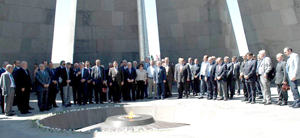
On August 31, 2011, the participants of the regular meeting of the MFA senior staff and the heads of the diplomatic missions visited Tsitsernakaberd Memorial Complex.
The members of the meeting put flowers at the eternal fire and honored the memory of the innocent victims with a minute of silence.
The regular meeting of the MFA senior staff and the heads of the diplomatic missions started on August 30 in the Conference Hall of the K. Demirjian Sports and Concert Complex.
The Participants of the 5th Pan-Armenian Games visited Armenian Genocide Memorial Complex
17.08.2011
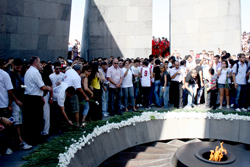
On August 16 the participants of the 5th Pan-Armenian Games coming from 125 cities of the world visited Tsitsernakaberd Memorial Complex of the Armenian Genocide. The delegations of the participant countries of the 5th Pan-Armenian Games put wreaths to the Memorial of the Armenian Genocide victims. The Armenian sportsmen put flowers to the eternal fire and with a minute silence honored the memory of the innocent victims.
The participants of the 5th Pan-Armenian Games visited the Armenian Genocide museum and got acquainted with the museum exhibition
President of Poland visited Tsitsernakaberd Memorial Complex
28.07.2011
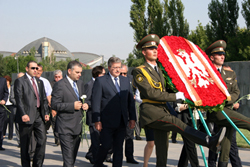
Today President of the Republic of Poland Bronislaw Komorowski, within the framework of his official visit to Armenia, visited Tsitsernakaberd Memorial Complex and put a wreath at the Memorial of the Armenian Genocide victims.
The Polish delegation headed by President Komorowski visited Armenian Genocide Museum, where they took a guided tour of the museum and President of the Republic of Poland Bronislaw Komorowski left the following note in the Commemoration Book. “I pay tribute to the victims. Poland also had a dramatic history. With a deep sympathy we bow to the tragedy of the Armenian people.”
Director of the Armenian Genocide Museum-Institute Hayk Demoyan handed President of the Polish Republic Bronislaw Komorowski a Golden medal which is given to the high-ranking officials who visit Armenian Genocide Museum.
At the end of the official visit President of Poland Bronislaw Komorowski planted a fir at the Memorial Alley of Tsitsernakaberd Memorial Complex.
House Foreign Affairs Committee Approves Berman-Cicilline Amendment Urging Turkey to Safeguard its Christian Heritage
21.07.2011
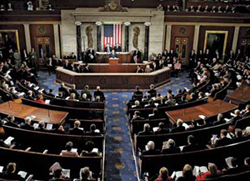
On July 20, 2011, the House Foreign Affairs Committee approved the Berman-Cicilline Amendment to H. R. 2583, the State Department-Foreign Relations Authorization Act for Fiscal Year 2012, urging Turkey to safeguard its Christian heritage, reported the Armenian Assembly of America (Assembly). The measure was adopted by a vote of 43-1, with Rep. Ron Paul (R-TX) as the lone vote against this overwhelming bipartisan amendment.
"This is a vote of justice against injustice," stated Archbishop Vicken Aykazian, Legate of the Eastern Diocese of the Armenian Church who was present during today's vote. "I hope that this will be the first of many steps towards preserving Armenian Christian heritage in Turkey," said Archbishop Aykazian.
Based on H.Res. 306, which was introduced by Congressmen Ed Royce (R-CA) and Howard Berman (D-CA), the Berman-Cicilline Amendment specifically urges "the government of Turkey to honor its obligations under international treaties and human rights law to -
The Presentation of Hayk Demoyan on Pan-Armenian Strategy and Concepts of the 100th anniversary of the Armenian Genocide
15.07.2011
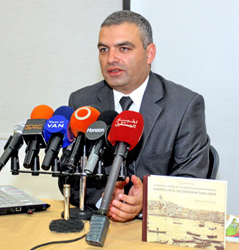
On July 13, 2011, in Azdak’s “Pyunik Hall” the 58th hearing was held by the Azdak editorial staff. The theme of the hearing was "The Pan-Armenian Strategy of the organization of events and conceptual approaches of the 100th anniversary of the Armenian Genocide ". During the hearing Hayk Demoyan, Director of the Armenian Genocide Museum-Institute and Secretary of the State Commission on Coordination of the events dedicated to the 100tհ anniversary of the Armenian Genocide, spoke in detail about the activities of the State Commission and emphasized that the 100th anniversary of the Armenian Genocide is a brilliant opportunity to show our solidarity and vigor to the world. Hayk Demoyan, within his speech, noted the importance of Genocide education; he spoke about various approaches as well as the necessity of the creation of specialized courses for teaching the Genocide both in the Diaspora and Armenia. Hayk Demoyan also mentioned that there is an issue with the transitional academic generation and steps must be taken to prepare new genocide scholars. He underlined the exceptional activity of the Armenian Genocide Museum-Institute and the organizing of annual events and its ongoing works.
Vatican Secret Archives on the Armenian Genocide
A Turkish Soldier’s testimony “We entered the Armenian villages and killed them all, without regard to gender and age”.
13.07.2011

The Vatican Secret Archives Officer Monsignor Sergio Pagano informed that the Vatikan will begin opening its secret archives. The secret archives, from the 8th century to the second half of the 20th century, will be opened in February 2012 and will be demonstrated in the “ Lux in Arcana” exhibition. Monsignor Sergio Pagano also mentioned that documents about the Armenian Genocide perpetrated by the Ottoman Empire at the beginning of the 20th century are also included in the archives.
“Relating to the Armenian Genocide there are documents that present acts of brutal violence by Turkish soldiers which are basically inhuman” said Pagano. After the official announcement Monsignor Sergio Pagano, the Vatican Archives Officer, was interviewed by the Turkish Vatan newspaper, which especially mentioned that in 1896 Pope Leo XIII of Rome called upon the Sultan to show compassion and stop the carried out massacres. Pagano stressed that the documents and information about the Armenian Genocide from Vatican’s secret archives will be published in a separate book. He cited several stories from the documents;
An eyewitness from Erzurum said, “I saw how numerous children were killed. My cousin ran away from home with a 2-year-old child on her shoulders, but she was shot and fell to the floor. Two soldiers came to her and killed her in front of the child. I saw the killing of our city’s spiritual leader. They gouged out his eyes, pulled his beard. Before killing him, the soldiers forced him to dance.”
The Speaker of the Ukrainian Verkhovna Rada Volodymyr Lytvyn visited Tsitsernakaberd Memorial Complex
11.07.2011

The Speaker of the Ukrainian Verkhovna Rada Volodymyr Lytvyn, within the framework of his official visit to Armenia, visited Tsitsernakaberd Memorial Complex and put a wreath at the memorial of the Armenian Genocide victims.
The members of the Ukrainian delegation put flowers at the eternal fire and honored the memory of the innocent victims with a minute of silence.
The Speaker of the Ukrainian Verkhovna Rada Volodymyr Lytvyn visited Armenian Genocide museum where he took a guided tour of the museum and left a note in the Commemoration Book. Volodymyr Lytvyn planted a fir at the Memorial Alley of Tsitsernakaberd Complex.
New entries in Ralph Yirikian collection at the Armenian Genocide Museum-Institute
22.06.2011
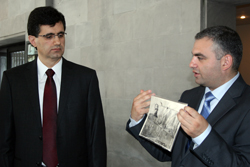 Today was the book presentation of Georges Brezol’s “Turks Have Passed Here” (in French), Ferriman Ducket’s “The Young Turks and the Truth about the Holocaust at Adana in Asia Minor” (in English), A. Adossides’s “Armenians and Young Turks: The Massacres in Cilicia” (in French) published by the support of VivaCell-MTS General Manager Ralph Yirikian, took place at the Armenian Genocide Museum.
Today was the book presentation of Georges Brezol’s “Turks Have Passed Here” (in French), Ferriman Ducket’s “The Young Turks and the Truth about the Holocaust at Adana in Asia Minor” (in English), A. Adossides’s “Armenians and Young Turks: The Massacres in Cilicia” (in French) published by the support of VivaCell-MTS General Manager Ralph Yirikian, took place at the Armenian Genocide Museum.
As a result of the already traditional cooperation between the Armenian Genocide Museum-Institute and VivaCell-MTS, the museum collection got new valuable museum items.
With direct support of VivaCell-MTS General Manager Ralph Yirikian, the museum’s collection was enhanced with unique items within the last six months, particularly by a collection of postcards with images of Western Armenia and Armenian themes, rare research literature , historical documents on humanitarian assistance provided to survivors of the Armenian Genocide, original photo footage of Armenian refugees, items, letters, stamps referring to the life of Western Armenians before the Genocide, photos of renowned Armenian families, as well as old newspapers of great exhibition importance. A considerable part of the exhibition items was obtained by the support of American-Armenian Hannessian family.
Foreign Minister of Swedish Kingdom Carl Bildt visited Tsitsernakaberd
14.06.2011

At the invitation of the Armenian Foreign Minister Edvard Nalbandyan Foreign Minister of Swedish Kingdom Carl Bildt visited Tsitsernakaberd Memorial Complex within his official visit to Armenia and put a wreath at the memorial of the Armenian Genocide victims. The members of the delegation put flowers at the eternal fire and honored the memory of the innocent victims with a minute of silence. The delegation of the Swedish Kingdom also visited Armenian Genocide Museum where they took a guided tour of the museum and Foreign Minister Carl Bildt left a note in the Commemoration Book.
Arbitral award of the President of the United States of America Woodrow Wilson has been published in its entirety for the first time.
31.05.2011
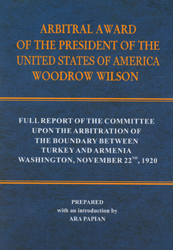
On May 30, the presentation of the first publication of the book “Full Report of the committee upon the Arbitration of the Boundary between Turkey and Armenia” by Ara Papyan took place at Armenia Marriott Hotel.
Woodrow Wilson’s Arbitral Award has never been published in its entirety. Only the seventh chapter was published some decades ago, about ten pages. This publication includes the actual decision as a whole – 86 pages, with 159 additional pages as appendices, along with all the corresponding maps, 25 in all. The publication has twelve pages as a preface, and 58 pages of indices including an index of names, of geographical locations, ethnic and religious minorities, and other subjects.
The role of US President Woodrow Wilson on the lives of the Armenian people was irrefutably great as well. As early as October, 1916, he called upon the people of the United States to donate to Armenian funds, officially declaring two days to that end. It was through his immediate involvement that those fundraising efforts got to be widespread throughout the country and, in a few years, the unprecedented amount of 130 million dollars was collected (equivalent to almost two billion today). Through Woodrow Wilson’s support, Near East Relief established tens of orphanages all over the Middle East, where more than a hundred thousand Armenian orphans were placed in good care and were saved from inevitable death by starvation right up the end of the 1920s. One can say with great confidence that, today, at least half a million Armenians owe their very existence to those American orphanages, which could not have functioned without US President Woodrow Wilson’s support.
The Arbitral Award of Woodrow Wilson is a legal and political tool for the Republic of Armenia.
The State Commission on Coordination of the events dedicated to the 100th anniversary of the Armenian Genocide held its first meeting
30.05.2011

The first meeting of the State Commission on Coordination of the events dedicated to the 100tհ anniversary of the Armenian Genocide on the head of the President Serzh Sargsyan took place today at the Government Reception House.
In the framework of the agenda of the first meeting of the State Commission on Coordination of the events dedicated to the 100th anniversary of the Armenian Genocide Hayk Demoyan, Secretary of the Commission, Director of the Institute-Museum of the Armenian Genocide, spoke about the organizational issues and the formation of an advisory group at the State Commission. Afterwards, Hranush Hakopian, the Minister of Diaspora Affairs spoke on the formation and activities of the regional groups which will be dealing with the coordination of the events dedicated to the 100th anniversary of the Genocide. The Minister of Foreign Affairs Edward Nalbandian presented to the Commission the issues conducted abroad and to coordinate the commemoration events towards the 100th anniversary of the Armenian Genocide.
Congratulations to Vahakn Dadrian
26.05.2011
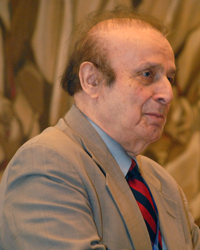
The Armenian Genocide Museum-Institute of the National Academy of Sciences of the Republic of Armenia has sent a letter of sincere congratulations to an Armenian American celebrated historian, professor of Sociology, world-famous scientist Vahakn Dadrian on his 85th anniversary.
“With you productive scientific activity of many years, you have become a living legend for the new generation of scientists. Your studies are precious in terms of giving a comprehensive scientific illustration of the historical reality of the Armenian Genocide, which significantly contributed to the international recognition and condemnation of the fact.
We are sure that your scientific path is life-long and you will still present new volumes and studies to the public.
We wish you health, long life and further scientific achievements.
With best regards and warmest wishes,
The staff of the Armenian Genocide Museum-Institute”.
AGMI PRESENTS A TEMPORARY EXHIBITION IN PARIS
18.05.2011
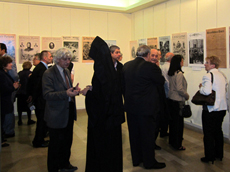
On May 14, the opening of the temporary exhibition “The Armenian Genocide – Front Page Coverage in Foreign Media” took place in Phrnjian Hall of the Armenian Apostolic Church of Paris, France. The exhibition had been organized by the cooperative efforts of the Armenian Genocide Museum-Institute and the Armenian Apostolic Church of Paris. The representatives of the French Armenian community, mayors of Clamart and Arnouville and Vigen Chitechian, RA Ambassador Extraordinary and Plenipotentiary to France were present at the opening ceremony.
This selection of 19th and early 20th century foreign newspapers, which is part of the Armenian Genocide Museum-Institute collection, has been acquired thanks to the generous support of Tigran Kalaydjian from Cyprus.
Archbishop Norvan Zakarian, Primate of the French Diocese of the Armenian Apostolic Church, Patrice Djololian, the leader of the French Diocese, and AGMI Director Hayk Demoyan gave their opening speeches.
The President of the European Parliament Jerzy Buzek at Tsitsernakaberd Memorial
18.05.2011
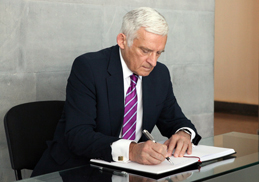
Today the President of the European Parliament Jerzy Buzek, within the framework of his official visit to Armenia, visited Tsitsernakaberd Memorial Complex, put a wreath at the memorial of the Armenian Genocide victims and put flowers at the eternal fire. The President of the European Parliament Jerzy Buzek visited Armenian Genocide museum where she took a guided tour of the museum and left a note in the Commemoration Book.
Afterwards the President of the European Parliament Jerzy Buzek planted a fir at the Memorial Alley of Tsitsernakaberd Complex.
Speaker of the Parliament of the Republic of Hungary visited Tsitsernakaberd Memorial Complex
17.05.2011
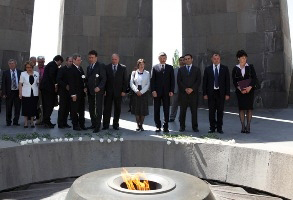
Speaker of the Parliament of the Republic of Hungary László Kövér who is on a two-day official visit to Armenia, visited Tsitsernakaberd Memorial Complex, laid a wreath at the memorial of the Armenian Genocide victims and also put flowers at the eternal fire. Speaker of the Parliament of the Republic of Hungary visited Armenian Genocide Museum where he took a guided tour of the museum and left a note in the Commemoration Book.
Afterwards László Kövér planted a fir at the memory park of Tsitsernakaberd Memorial Complex.
President of the OSCE Parliamentary Assembly Petros Efthymiou visited Tsitsernakaberd Memorial Complex
10.05.2011
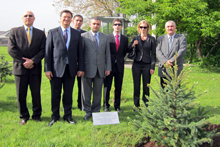
On May 10, President of the OSCE Parliamentary Assembly Petros Efthymiou, within his two day visit to Armenia, visited Tsitsernakaberd Memorial Complex and put a wreath at the memorial of the Armenian Genocide victims. Afterwards the members of the delegation put flowers at the eternal fire.
President of the OSCE Parliamentary Assembly Petros Efthymiou planted a fir at the Memorial Alley of Tsitsernakaberd Complex.
President of Lithuania Dalia Grybauskaite Visited Memorial of the Armenian Genocide Victims
05.05.2011
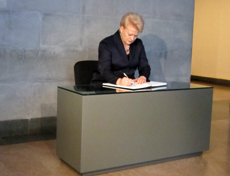
On May 5, President of Lithuania Dalia Grybauskaite, who was in Armenia within the framework of her visit to the South Caucasus, visited Tsitsernakaberd Memorial Complex and put a wreath at the memorial of the Armenian Genocide victims. President of Lithuania Dalia Grybauskaite visited Armenian Genocide museum where she took a guided tour of the museum and left a note in the Commemoration Book in the name of Lithuanian people. Director of the Armenian Genocide Museum-Institute Hayk Demoyan handed President of Lithuania Dalia Grybauskaite a golden medal which is given to the high-ranking officials who visit Armenian Genocide museum.
Afterwards, Dalia Grybauskaite planted a fir at the Memorial Alley of Tsitsernakaberd Complex.
The Armenian Genocide and Jewish Holocaust Memory: Structural Peculiarities
04.05.2011
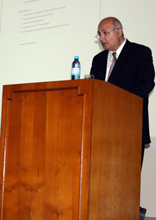
On May 4 a public lecture titled “Armenian Genocide and Jewish Holocaust Memory: Structural Peculiarities” by anthropologist Harutyun Marutyan was organized at the Armenian Genocide Museum-Institute dedicated to the commemoration of Holocaust victims. Dr. Harutyun Marutyan is a Leading Research Fellow at the Department of Contemporary Anthropological Studies at the Institute of Archaeology and Ethnography, National Academy of Sciences of Armenia, and a Visiting Professor of Anthropology at Yerevan State University. In 2009-2010 he was Diane and Howard Wohl Fellow at Center for Advanced Holocaust Studies, US Holocaust Memorial Museum (Washington, DC) conducting research for his project "Memory Based on Politics: Comparative Study of Jewish and Armenian Experience."
Dr. Marutyan raised and analyzed the following questions: periodicity of the history of the Armenian Genocide and Jewish Holocaust and frequently given characterizations about their uniqueness and significance, as well as the term "Holocaust".
A ceremony of tribute at Tsitsernakaberd memorial
24.04.2011
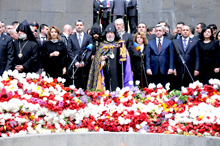
Today is the Remembrance Day of the Armenian Genocide victims. Every year on April 24 hundreds of thousands of Armenians from Armenia, Diaspora as also numerous foreign citizens march to Tsitsernakaberd Memorial Complex to pay tribute and lay flowers at the eternal fire.
President of Republic of Armenia Serzh Sargsyan, Prime Minister Tigran Sargsyan, Catholicos of all Armenians His Holiness Garegin II, members of parliament and government of the Republic of Armenia were among the first visitors. They honored the memory of innocent victims with a minute of silence, after which His Holiness Karekin II, Catholicos of All Armenians prayed for the repose of the victims’ souls.
The President of Armenia and government officials visited also the temporary exhibition "Armenian Genocide and Scandinavian response" opened at the Genocide Museum.
The flow of people did not cease at the eternal fire.
The Valuable Work “Armenians and Young Turks. The Massacres in Cilicia” in Armenian
24.04.2011

The Armenian Genocide Museum-Institute of NAS RA presents the valuable work of French journalist A. Adosides “Armenians and Young Turks. The Massacres in Cilicia” translated into Armenian. The book was first published in Paris in 1910. In his work the author guided by the testimonies of American, English and French diplomats and missionaries. Adosides in detail discusses the massacres of the Armenians that took place in Cilicia and Aleppo and analyses their reasons. The murder of several hundred Greeks and Assyrians during the extermination of the Cilician Armenians the author considers as coincidences pointing out that the orders of massacres in Adana and adjacent regions concerned merely the Armenians.
Among the reasons of the massacres of the Cilician Armenians the author emphasizes the prosperity of the Christian population and the flow of the Armenians from the inner provinces to Cilicia.
The author gives great importance to the self-defense organized by the Armenians in Cilicia. He analyses also some problems concerning the policy of the great European powers.
The work of Adosides has greatly contributed to raising awareness and knowledge of the contemporaries.
The French and Armenian editions of the book were sponsored by Ralph Yirikian.
The book by Jakob Küntzler “In the Country of Blood and Tears” in Armenian
24.04.2011

The Armenian Genocide Museum-Institute presents a book titled “In the Country of Blood and Tears” by Swiss missionary Jakob Küntzler in Armenian translation, which has a primary source value and describes the events of Urfa during World War I. The fact that the author of the book was an eyewitness to the events makes the memoirs more valuable for the student of the Armenian Genocide implementation details.
Arriving in Urfa in 1899 Jakob Küntzler started working at the hospital of “German Mission in the East” organization as an assistant to Swiss Doctor Hermann Christi. During the World War I he was the only one who was able to provide medical assistance to the people of Urfa and the neighboring settlements.
J. Küntzler and his wife Elizabeth succeded in saving many Armenians from imminent death.
The book is designed primarily to meet the needs of historians, researchers in Oriental Studies, as well as for wide circle of readers.
The Decree of President of the Republic of Armenia
To set up a State Commission to co-ordinate the events dedicated to the 100th anniversary of the Armenian Genocide
24.04.2011
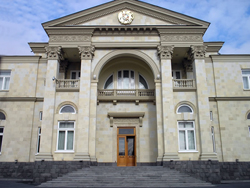
According to the decree of President of RA Serzh Sargsyan to promote the process of international recognition and condemnation of the Armenian Genocide a State Commission has been established and the members have been confirmed. The chairman of the Commission is Serzh Sargsyan.
According to the decree of President, a number of assignments were given to the ministries, departments, and diplomatic representatives of RA, and the National Academy of Sciences of RA.
In particular it has been assigned;
To the Ministry of Foreign Affairs of RA and the Ministry of Diaspora of RA to support to the formation of regional committees to organize the events dedicated to the 100th anniversary of the Armenian Genocide and coordination of their activities.
To the Embassies of RA to activate the efforts toward the international recognition of the Armenian Genocide.
The first meeting of the State Commission to organize the events dedicated to the 100th anniversary of the Armenian Genocide will be held in Yerevan, on May 30, 2011.
The director of the Armenian Genocide Museum-Institute Hayk Demoyan has been appointed the secretary of the State Commission.
“Armenian Genocide and Scandinavian Response”
Temporary Exhibition at the Armenian Genocide Museum
23.04.2011
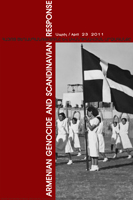
The Armenian Genocide had a major impact on the international community from the moment the information about the massacres being implemented by the Young Turks reached foreign offices and appeared on the front pages of newspapers in 1915, thus becoming a reason for the public humanitarian response and protest. In this regard, the Scandinavian countries were no exception.
Individuals, organizations, and governments in Sweden, Norway, and Denmark reacted in a variety of ways to the ongoing massacres in Armenia. The first records about the help from the Scandinavian countries to the Armenians being persecuted by the Turkish tyranny dated back to 1890s during the reign of “Bloody Sultan” Abdul Hamid II. In reply to the committed crimes, in the Scandinavian countries many books were published and steps were taken to help the suffering Armenians.
Swedish, Norwegian, Danish diplomats, missionaries, relief workers in the Ottoman Empire as well as many individuals in Scandinavian countries - writers, priests, reporters, even school children contributed to raising the awareness of the Armenian atrocities and their human and political implications and collected funds for the humanitarian aid. The Scandinavian missionaries’ work to aid the Armenian population of the Ottoman Empire was coordinated by the Danish, Norwegian and Swedish “Women Missionary Workers” organization (KMA in Danish: Kvindelige Missions Arbejdere).
A Memorial Ceremony in Honor of the Famous Scandinavian Missionaries Maria Jacobsen and Alma Johansson
21.04.2011
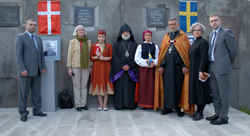
On April 21, 2011 AGMI organized a ceremony dedicated to prominent Scandinavian missionaries Maria Jacobsen and Alma Johansson: the soils brought from their graves were placed in the “Memorial Wall” and memorial plaques were set.
The citizens from Scandinavian countries and deputies from Swedish Parliament are in the Republic of Armenia to take part in this ceremony.
The placement of the soil taken from the burial sites of both missionaries in the “Wall of Memory” was accompanied by the religious ceremony in Armenian and Swedish languages.
At the end of the ceremony the guests from Scandinavian countries planted a Scandinavian Tree at the Memorial Alley in memory of Scandinavian Armenophiles.
The International Conference – “The Armenian Genocide and the Scandinavian Response”
21.04.2011
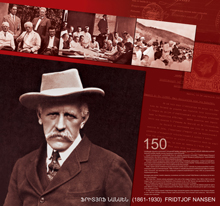
On April 20 and 21, 2011 Armenian Genocide Museum-Institute organized an international conference titled “The Armenian Genocide and the Scandinavian Response” dedicated to Fridtjof Nansen’s 150th anniversary. During the conference, historians and researchers from Armenia, Sweden, Denmark, and Norway presented papers on various aspects of the topic.
The Armenian Genocide was met with a great international response, drawing the attention of the international community and the media. The Scandinavian countries were no exception. Governments, organizations, and individuals from Sweden, Norway, and Denmark reacted in a variety of ways to the ongoing crisis in Armenia.
The Scandinavian missionaries’ efforts directed at helping the Armenian people suffering massacres in the Ottoman Empire, and at proselytizing among them, were mainly realized by the Danish, Norwegian, and Swedish branches of the Women Missionary Workers organization (KMA; Kvindelige Missions Arbejdere).
The first winner of the Raphael Lemkin annual scholarship announced
19.04.2011
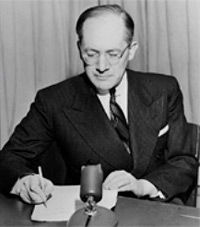
The first winner of the Raphael Lemkin annual scholarship announced by the Armenian Genocide Museum-Institute is Rebecca Jinks, a post-graduate student of Royal Holloway University of London, Department of History & Social Sciences. R. Jinks is interested in Armenian genocide and Holocaust studies. She has got several academic awards and speaks English, German and Serbian.
In September 2010 the Armenian Genocide Museum-Institute of NAS RA announced its new scholarship program for foreign students and PhD candidates. Raphael Lemkin scholarship is intended to enable foreign students, who specialize in genocide studies, especially in the Armenian Genocide, to visit Armenia for a month to conduct research in local scientific institutions and libraries.
The Armenian Genocide Museum-Institute will provide researchers possibility to carry out their research at the AGMI, where they will be provided with necessary research materials and consultation, as well as in the universities, archives and libraries located in Armenia.
The scholarship suggests a visit of one postgraduate student per year. The AGMI covers all travel and accommodation expanses related to the nominee. The AGMI is planning to enlarge this scholarship program to promote the development of scholars specialized in Armenian genocide.
ARMENIAN WEDDING IN THE OTTOMAN EMPIRE
19.04.2011
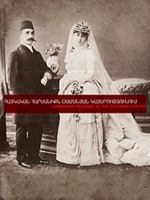
In various societies the family is a most important institute for the transmission of material, spiritual, and cultural values to the next generation. For Armenians, in the absence of their own independent statehood and under foreign domination, the family for centuries has played an indispensable role in preserving national value system and national identity.
By the end of the 19th - beginning of the 20th century matrimonial customs of western Armenians were an important pre-requisite for the preservation of national identity. The marital customs of the Ottoman Armenian were multi-content, sometimes highly diverging yet preserving their religious and national meaning. The formal marriage brokerage could take place in different places from the 'cradle' or from one's childhood years whereas in some other places it could happen only after puberty. The marriage brokerage was followed by engagement ceremony attended by the local priest who blessed the festive table. The weddings among Armenians were normally celebrated on Saturdays when the groom accompanied by his parents was bringing the bride from her parents' home.
British Parliamentarians Visit Tsitsernakaberd Memorial Complex
19.04.2011
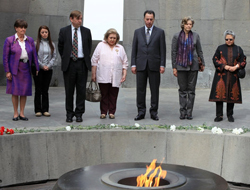
On April 19 the members of the delegation headed by the Chairwoman of the British-Armenian All-Party Parliamentary Group of the Parliament of the United Kingdom of Great Britain and Northern Ireland Baroness Caroline Cox visited Tsitsernakaberd Memorial Complex. The members of the deligation laid flowers in memory of the Armenian Genocide victims and visited the Genocide Museum. Afterwards, Baroness Caroline Cox watered the fir-tree she had planted in 2002.
At the museum speaking to the journalists Baroness Cox stated “My feelings are always with your people. We remember the heinous and tragic events of1915. It is a pleasure to me that today the representatives of the House of Lords and House of Commons, who are included in the British-Armenian All-Party Group, are with me in Armenia”.
Lord Lyndon Harrison, who was in Armenia for the first time, noted that he had visited memorial complexes dedicated to memory of the nations in many countries, but what he learnt at the Armenian Genocide Museum, was the most impressive one.
To the question whether Great Britain would officially acknowledge the Armenian Genocide or not, the Vice Chairs of the All-Party Parliamentary Humanist Group Baroness Shreela Flather said “I am sure that one day it will happen. Our parliamentary group makes a lot of efforts to inform the people about the Armenian Genocide as many people are not aware of it.”
The member of the House of Commons John Whittingdale emphazised the importance of their visit to Tsitsernakaberd Memorial Complex and Genocide Museum as many other people in Britain he did not have much knowledge on the Armenian Genocide.
Argentine Federal Court Unprecedented Ruling on the Armenain Genocide
14.04.2011

On April 1, 2011 Argentine Federal Court sustained a claim by Argentine-Armenian, Gregory Hairabedian against the Turkish state. Federal Judge Norberto Oyarbide’s ruling states "The Turkish state was implementing a systematic program aimed at the extermination of the Armenian nation from 1915 to 1923". In 2000, G. Hairabedian applied the court demanding Turkey be responsible for the fate of his 50 relatives from Svaz and Kharberd who disappeared during World War I and in the proceeding years. The court has decided that Turkey should help the Armenians living in Argentina learn about their ancestors, who were killed or disappeared during the Genocide. At the same time the judge has stated that his ruling is declarative.
To reach the final verdict the court has examined the documents collected from Great Britian, German, Unitied States, Vatican for 11 years. The secret telegrams of the consuls and ambassadors recevied from Germany were of great importance as they revealed the Turkish policy of extermination of the Armenian nation.
President of Switzerland at Tsitsernakaberd Memorial
31.03.2011

At the invitation of RA President Serzh Sargsyan President of Switzerland Micheline Calmy-Rey visited Tsitsernakaberd Memorial Complex and put a wreath at the memorial of Armenian genocide victims within a two-day official visit to Armenia.
The President of Switzerland Micheline Calmy-Rey watered a fir at the Memorial Alley which has been planted in 2006.
It should be noted; on December 16 2003, the Swedish Parliament has adopted a resolution recognizing the mass murders of the Armenian people at the 20th beginning of the century and that the denial of the Armenian genocide considers being punishing act in Switzerland.
"KARABAKH AND TURKEY’S GENOCIDAL ATTEMPTS" by Hayk Demoyan
10.03.2011
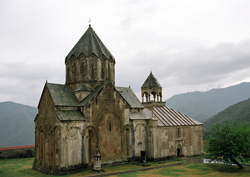
At least three times in history Turkey has tried to commit genocidal acts while striving to implement the policy of total extermination and deportation of the Armenian population from Karabakh. From the historical point of view Turkey’s current stance and attempts to put preconditions to Armenia and the policy of pressure with the intent to get necessary concessions from Armenia in the settlement of Karabakh issue seem very actual; moreover, the references to the historical records are important in shedding a light on the origins of the ‘Turkish strategy’ in Karabakh issue.
The first attempt
The expansion of the borders of the Ottoman Empire in the Caucasus has started from the 16th century. On the way to the Caspian shores the Turkish armies faced with the heavy resistance of the Armenians of Artsakh (Karabakh) and many times have suffered defeats from the organized resistance of the Karabakh Armenians. In 1725 Sultan Ahmet III (1703-1730) issued a special fatwa to exterminate Armenians for their successful resistance against the Ottomans and ordered to kill them all for bringing the Russians into the Caucasus and blocking the access of the Ottomans towards Baku.
Marmnamarz - 100
24.02.2011
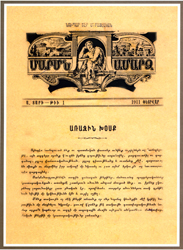
In 1908, after the revolution of the Young Turks, the Armenian community concerned with the development of sport and gymnastics among the youth. To encourage the spread of gymnastics there was a necessity to establish a newspaper. In February 1911 the first sport magazine Marmnamarz (The Gymnastics) was published in Constantinople. The interest of the Western Armenians toward gymnastics was due to the foreign, and particularly, American colleges operating in the Empire. The “Armenization” of the sportive movement from 1911 to 1914 was due to Marmnamarz published by Sharvarsh Krisyan. The executive director of the magazine was Karo Untsyan. In the beginning, a writer – publicist Hakob Siruni participated in and supported the publication of the journal. Marmnamarz was the first sport newspaper published in the Ottoman Empire and was a unique phenomenon in the history of the Western-Armenian press.
From the very beginning Marmnamarz had several crucial objectives: to create interest towards gymnastics and sport in the towns and villages of Western Armenian largely inhabited with the Armenians, to give information about the sport events happening in the Empire and in the world wide, to become the coordinator of the sport clubs and competitions. Armenian and foreign authors had their articles about gymnastics, health, pedagogy and the development of sport in Marmnamarz.
Website on the history and destruction of the Armenian community of Baku city
23.02.2011
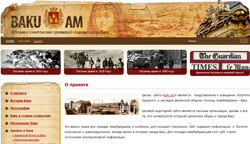
The presentation of www.baku.am website took place in “Picasso Hall” of Congress Hotel on February 23, at 12.00.
The Armenian Genocide Museum-Institute has initiated and presents a unique trilingual website covering the social, political, cultural and business life of the Armenian community in Baku. Hundreds of photographs, illustrations and post cards demonstrate the history of Armenian families, Armenian buildings, and Armenian press issued in Baku, publishing, advertisements and generally the history of Armenian cultural existence in Baku.
Separate section is dedicated to photographs and documents covering the Armenian massacres of 1905, 1918 and 1990 in Baku.
Foreign Affairs Minister of China Yang Jiechi Paid a Tribute
17.02.2011
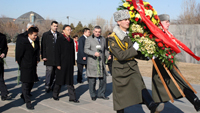
On February 16-17, Foreign Affairs Minister of China Yang Jiechi, who is in Armenia at the invitation of the Armenian Foreign Affairs Minister Edward Nalbandyan, visited Tsitsernakaberd Memorial Complex and put a wreath at the memorial of Armenian genocide victims within the framework of the official visit to Armenia.
Afterwards the Chinese delegation took a tour of the Armenian Genocide Museum, where Mr. Yang Jiechi left a note in the Commemoration Book.
Foreign Affairs Minister of Ukraine visited Tsitsernakaberd Memorial Complex
11.02.2011
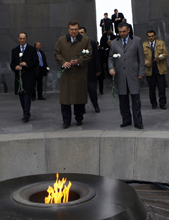
On February 10-11, at the invitation of Armenian Foreign Affairs Minister Edward Nalbandyan, Foreign Affairs Minister of Ukraine Konstantin Grishchenko visited Tsitsernakaberd Memorial Complex within the framework of the official visit to Armenia.
The Foreign Minister Konstantin Girshchenko put a wreath at the memorial of the Armenian genocide victims and visited Armenian genocide museum. The Foreign Minister took a guided tour of the museum and got introduced to the details concern the history of the Armenian genocide. Afterwards, Konstantin Girshchenko left a note in the Commemoration Book.
Georges Brezol: “Turks Have Passed Here...”
23.12.2010
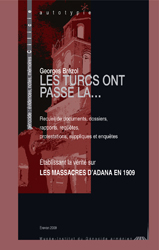
Armenian Genocide Museum-Institute of NAS RA reprinted the rare monograph of Georges Brezol “Turks Have Passed Here…”. The book is a valuable source on the Armenian massacres in Adana in April, 1909. It contains unique documents, testimonies and photographs concerning Adana massacres of 1909. The documents included in this book help us to orientate in different interpretations concerning the Cilician massacres perpetrated before and after the Young Turks’ coup. The monograph published by Georges Brezol is the only documentary publication dedicated to the historiography of Cilician massacres, which allows us to have a notion about the massacres organized in Cilicia and adjacent regions confronting various primary sources.
The book for the first time was published in Paris, 1911. The monograph is the second edition of the “Cilician Series of Books” sponsored by Ralph Yirikian, executive Director of VivaCell-MTS.
| 




